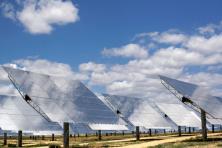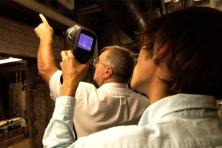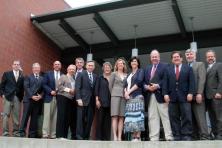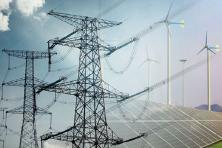On August 1, the City of Portland graciously hosted the Northwest Biocarbon Initiative (NBI) along with our partners at Ecotrust and the Willamette Partnership to announce the release of NBI’s new report, Natural Infrastructure: A Climate-Smart Solution.
Linda Dobson and Emily Hauth from Portland’s Bureau of Environmental Services led a fascinating tour of Portland’s green streets, ecoroofs, bioswales, and several other examples of natural infrastructure and biocarbon solutions that capture CO2, save money, create jobs, and enhance our communities. Other regional experts were on hand, including Michael Armstrong from Portland’s Bureau of Planning and Sustainability and Mike Houck of the Urban Greenspaces Institute.
Among the climate change initiatives announced by the Obama administration in June of this year, the President cited the use of natural systems to capture carbon as a priority going forward. The Northwest region is leading the nation in using biocarbon and natural infrastructure solutions in cities, forests, rural communities, wetlands, and the ocean to store carbon and remove carbon pollution from the atmosphere.
By spearheading innovations that harness the power of natural systems, Oregon and Washington are at the forefront of addressing the three climate imperatives: (1) reduce reliance on fossil fuels; (2) remove existing carbon pollution; and (3) build resilience to withstand climate impacts. Natural Infrastructure: A Climate-Smart Solution explores the way that natural infrastructure solutions function, citing examples of a variety of natural solutions at work throughout the Northwest.
Take a look at some quotes from the day:
"Portland uses green infrastructure to manage our stormwater and keep our rivers clean,” said Portland Commissioner Nick Fish. “One of the great things about green infrastructure is that it has multiple benefits, including reducing carbon pollution in our atmosphere.”
“Green or natural infrastructure helps our grey, pipe infrastructure work more efficiently; it helps cool the air; it creates green spaces in urban areas; it creates habitat for birds and beneficial insects," said Linda Dobson.
Dobson noted that since 1990, carbon emissions are down by more than 8 per cent in Portland, while nationwide emissions increased 10 percent.
"In 2009, Portland adopted the goal of reducing carbon emissions by 40 percent by 2030," Dobson explained. "Now we are beginning to realize that our growing green infrastructure is a valuable tool in reducing the amount of harmful carbon in our atmosphere not only by helping to reduce overall carbon emissions, but also by capturing existing carbon already produced.”
"In Oregon, restoration and natural infrastructure projects have created jobs in construction, in technical fields, such as engineering and wildlife biology, and in supporting businesses like plant nurseries, heavy equipment companies, and rock and gravel quarries,” said Cathy Kellon, Director of Water and Watersheds Program at Ecotrust. "These are jobs that can't be outsourced."
"Everything we do today is more connected: people, economies, communication. Why aren't we looking at the environment that way?" asked Bobby Cochran, Executive Director for the Willamette Partnership. "Building up our natural infrastructure – from farms to floodplains to green streets – cleans our water, stores carbon, increases local food production, and ultimately makes our communities healthier and happier.
A fantastic day all around! Many thanks to the City of Portland, Ecotrust, the Willamette Partnership and the Urban Greenspaces Institute for helping to pull it together and even more so, for their ongoing work pioneering natural infrastructure innovations that are saving money, beautifying communities, improving air and water quality, and capturing carbon.




